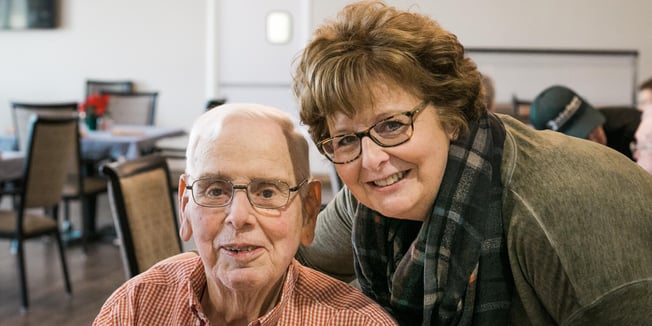What to Know About Working While Being a Caregiver

Caring for a family member as they age can be rewarding. However, you may also find yourself trying to juggle several different major life responsibilities during this time, including your job.
How can you maintain the balancing act with all of your other responsibilities while being a caregiver to a senior loved one? Let’s explore tips to help you balance being a caregiver with your responsibilities at work.
1. Talk with your employer.
You may wonder how (or if!) you should tell your employer about your caregiving responsibilities, especially because you don’t know what it means for your workload or position. It’s important to be transparent with your employer about being a caregiver while balancing work.
If you’re lucky enough to have a supportive manager, they may help you come up with ways to create more flexibility in your work schedule or workload. This could mean modifying your daily schedule or exploring flex time or remote work options.
If your workplace doesn’t have a formal policy in place to accommodate family caregiving responsibilities, they may still make arrangements to support your unique circumstances. Make sure to discuss the options available to you. For example, you may be able to use your accrued sick time or vacation time for caregiving.
You may also want to consider taking advantage of your workplace’s Employee Assistance Program or another resource for caregivers. These options can offer resources on time management or counseling for managing stress.
2. Know your rights under the Family and Medical Leave Act.
The Family and Medical Leave Act (FMLA) enables certain employees to take up to 12 weeks of unpaid leave per year without losing health benefits or job security to care for a parent, child, or spouse with a serious health condition. You may take all 12 weeks of leave at the same time or intermittently.
To be eligible for FMLA, you must work for a company that has at least 50 employees within 75 miles of the worksite or work within the public sector. You must have also worked for your employer at least 1,250 hours over the last 12 months (approximately 24 hours a week). To request an FMLA absence, you may have to submit paperwork that confirms your loved one’s condition and their need for care
It’s important to note that FMLA doesn’t cover leave to care for in-laws. Additionally, if the leave is considered “foreseeable,” such as taking time off to care for your loved one after they have a scheduled surgical procedure, you’ll need to give your employer at least 30 days’ notice.
3. Don’t do it all yourself.
A common mistake many people make when caregiving and working full time is to believe they have to do everything themselves. In truth, family members and friends may simply not know how to help or realize that help is needed. It's essential for your well-being to seek help where you can, and it’s okay to ask other family members, friends, or a partner to help out.
Some steps that can bring additional support into your life include asking your partner to take care of housekeeping duties and meals around your home. You may also find it helpful to create a list of tasks you need assistance with and send it to family and friends so they can divide up the list and help you tackle those things.
Plenty of different delivery services are available today, from grocery deliveries to meal kits and pharmacy orders. These services enable you to use your caregiving time more efficiently, saving the stress of extra car trips and navigating grocery and pharmacy parking lots.
4. Take care of yourself.
When caring for a loved one and working full time, you can easily forget to focus on yourself and your own needs. To be your best for your loved one, make sure you’re taking care of yourself and are feeling rested, happy, and healthy as well.
You may not have much time for self-care, but it’s important to make sure you’re eating well, exercising, and relaxing when you can to maintain energy and good health while reducing stress. Eating three full meals a day plus snacks in between is key to fueling your busy days. Focus on a variety of vegetables, whole grains, and proteins such as chicken, fish, beans, and eggs for steady streams of energy without the spikes from processed and sugary foods.
Not sure which lifestyle option is right for you? We've got a quiz for that. Answer a few questions to get direction from our experts.
Take the Quiz5. Consider whether it’s time for senior living.
Being a caregiver for a senior loved one is an incredibly rewarding experience. You have the unique opportunity to support them day-to-day and improve their quality of life. In addition to supporting your loved one, you also face new challenges such as handling your loved one’s escalating appointments, medications, and personal care needs.
Caregiver burnout is a challenge that occurs when a caregiver is feeling stressed and overwhelmed from their responsibilities, and they can’t or don’t take occasional breaks from caregiving to destress and recharge. This is why it’s so important to seek assistance from other family members and friends as well as make sure you’re eating well, resting, and exercising.
If you’re experiencing caregiver burnout or your loved one needs additional support that is beyond your capabilities to provide, you may be wondering if it’s the right time for senior living. Senior living communities provide the support and lifestyle each resident needs to stay healthy and live life to its fullest.
Senior living offers plenty of benefits, both for your senior loved one and for you.
A Welcoming Environment for the Whole Family
Senior living communities embrace their residents’ family members and regularly include family events on the community calendar. From welcoming dining halls and beautiful apartments to special events like barbecues and concerts, residents and their families can enjoy spending quality time together rather than focusing only on caregiving tasks.
Opportunities for Socialization
Socialization is important for healthy aging, and it’s a highly effective way to improve an individual’s mental health and reduce stress. Senior living communities recognize how important socialization is, so they’re designed to help residents build new connections and strengthen existing ones. From community dining areas to popular walking paths, there are plenty of opportunities to meet others with similar interests and build social circles.
Around-the-Clock Care
Senior living communities are staffed by team members who are accustomed to providing around-the-clock care to each resident, as needed. Communities provide the amount of support your loved one requires through emergency response systems, accessible apartments, natural and artificial lighting, and wellness resources.
Ready to learn more about the power of senior living?
Socialization is about more than having fun; it also has a large impact on mental and physical health. Find out how senior living communities can provide opportunities for socialization with The Power of Connection for Senior Health.





.png?width=307&height=200&name=Blog%20%2333%201400%20x%20700%20(1).png)

.png?width=307&height=200&name=Blog%20%2332%201400%20x%20700%20(8).png)



